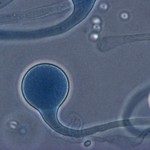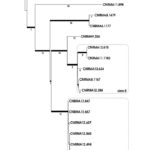Lien vers Pubmed [PMID] – 32335966
Lien DOI – 10.1111/myc.13095
Mycoses 2020 Jul; 63(7): 737-745
Yarrowia lipolytica belongs to the normal human microbiota but is also found in substrates with high contents in lipids and used in biotechnological processes. It is sometimes reported as human pathogen and especially in catheter-related candidaemia.Two apparently grouped cases of infections and/or contamination were reported involving 3 and 9 patients, respectively, in two hospitals. The goal of this study was to design a molecular tool to study the genetic diversity of Y lipolytica and confirm or not the common source of contamination during these grouped cases.Given that there is no genotyping method, we used genomic markers assessed on environmental isolates to determine intra-species relationship. We selected five highly polymorphic intergenic regions, totalling more than 3200 bp and sequenced them for clinical (n = 20) and environmental (n = 14) isolates. Antifungal susceptibility was determined by EUCAST broth microdilution method.Multiple alignment of the five sequences revealed divergence of 0%-5.8% between isolates as compared to approximately 0.2%-0.25% after alignment of whole genomes, suggesting their potential usefulness to establish genetic relatedness. The analysis showed the multiple origins of the isolates. It uncovered two grouped case of fungaemia involving 3 and 2 patients, respectively. It also revealed several unrelated sporadic cases despite their temporal relationship and one probable laboratory contamination by a common yet uncovered source, explaining several consecutive positive cultures without infection. All isolates had high minimal inhibitory concentration (MIC) for flucytosine, the majority (14/34) was susceptible to fluconazole, and all to the other antifungal agents tested.This method could help elucidate cases related to the opportunistic pathogen Y lipolytica.




